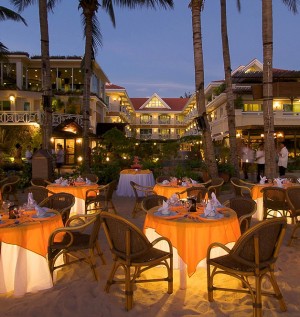A Visual Feast at Boracay Island
He showed us how he could crack his neck and twist his wrist in unnatural ways and tried to carry our bikes at every opportunity. Some other locals came to tell him to back off, but he just got annoyed and brushed them aside, much to our discomfort. For a while the natural power and beauty of our location was enough to justify his pestering, but it was ultimately a small beach, with only so much to explore under those circumstances. When we’d finally had our fill of his canned lines and attempts to look at Kristine’s cleavage, we gave him 20 pesos and headed back to return our bikes.
Exploring Boracay’s isolated areas certainly makes for a rewarding few hours, but sooner or later, most visitors find their way back to the tourist strip for more conventional vacationing. There’s plenty of that available, whether it takes the form of lounging on the beach or engaging in some good, old-fashioned consumerism.
The beach really is everything you’d expect from a world-class Oceanside destination; all perfect with fine sand and clear ocean water against a diverse spectrum of baby blue shades in the open sky. And yet that diversity is minor compared to the number of ways you can part with your pesos, a fact you rarely have the chance to forget.
Like any commercial beach, there are countless souvenir shops hocking Bob Marley and John Lennon shirts, sandals, postcards, crocodile heads and the like. But the genuinely bothersome representation of in-your-face capitalism comes from the hordes of locals hell-bent on selling you water activities like parasailing and diving.
Of course, many people do go to places like Boracay looking for such activities, but after the hundredth unsolicited, “Hello, sir, jet ski?” accompanied by a laminated water sports menu, even the easiest-going tourist is likely to be fed up. We managed to shrug them off a bit faster than most, since Kristine shares their native language, but it grates on the nerves all the same.
Thankfully, it’s never hard to eat yourself past such petty annoyances in places like this. Restaurants represent about two dozen types of international cuisine, with a common focus on Asian, American, and European flavors. The cheapest, like the prevalent Mang Inasal chain, tend to serve universally palatable native Filipino fare. This means lots of rice, chicken and gravy, and soups like the sour hangover-busting favorite Sinigang.
Beyond that on the price scale are high-end burgers, Spanish tapas, sushi, and pizza. But the real attraction is the plethora of seafood.
Massive beach buffets are set up each evening, but for the freshest stuff there’s D’Talipapa square, an open market where customers can buy fish, shells, crustaceans and the like, and then take them to nearby restaurants waiting to prepare your choices for you. Some specialize in curries or Chinese preparation, others in more standard grilling.
Between the variety of sea creatures and cooking styles, it’s possible to eat a different meal every day of the week – presuming your wallet holds up. It doesn’t turn out any cheaper than going to a regular restaurant, but it is fun to personally choose hand-sized prawns and marlin steaks, or to be reminded just how many colors nature can cram onto a lobster’s shell before it’s cooked.
If you’ve managed to avoid eating yourself into a food coma (or if you can recover in decent time), Boracay still has plenty to offer once the sun goes down – these places are virtually obliged to entertain, if they want to please the visitors that make up their economies. While the seafood buffets add local Filipino cover bands to entertain the diners they already have, there are myriads of bars slinging happy hour San Miguel beer and cocktails to lure in wanderers.
Some of the best evening locales combine drink specials, beach dining, and entertainment all in one. This was the case with The Boracay Mandarin Island Hotel, which, in conjunction with the two restaurants to either side, put on one of the best shows on the island. Excellent fire performers plied their trade on the sand in front of a multinational crowd downing buckets of San Miguel and the free Buffalo wings that came with them.
The performers represented both genders and were visibly enjoying both their dances and the adoration of the crowd. It helped that the music they used was a better electronic mix than much of what’s played in dance-pop heavy clubs like Summer Place. Eventually they ventured into the audience area to playfully throw fire just short of guests’ faces (the horrified reactions of the many Korean tourists, who perpetually pour into Boracay, were priceless) and light cigarettes by rapidly spinning their flaming balls and chains, mine included.
The fire was followed by a solid cover band, but nothing out of the ordinary. Filipinos are essentially the world’s number one lounge performers, take that as you will, and this one followed the standard set-up of male and female vocalists with a crack band behind them. They ran through faithful takes on heartfelt ballads, arena rock and Eagles songs, and even invited audience members to sing with them, if they had any requests. Of course the performances are timed to stop just as everyone’s gearing up to begin anew the ancient cycle of getting thoroughly twisted, and from there it’s pretty standard fare debauchery.
Assaulted as you can be by the typical tropical beach package of salesmanship, food and revelry, it’s easy to forget that a different world exists less than an hour away in either direction. It’s fortunate, then, that the port to leave the island is well outside of the tourism zone. It ensures that you’ll have one last reminder of the stark contrast, at least until you look back from your boat and see all of the differences have faded from sight, consumed by the brilliant green that makes so much of the country a visual feast.

